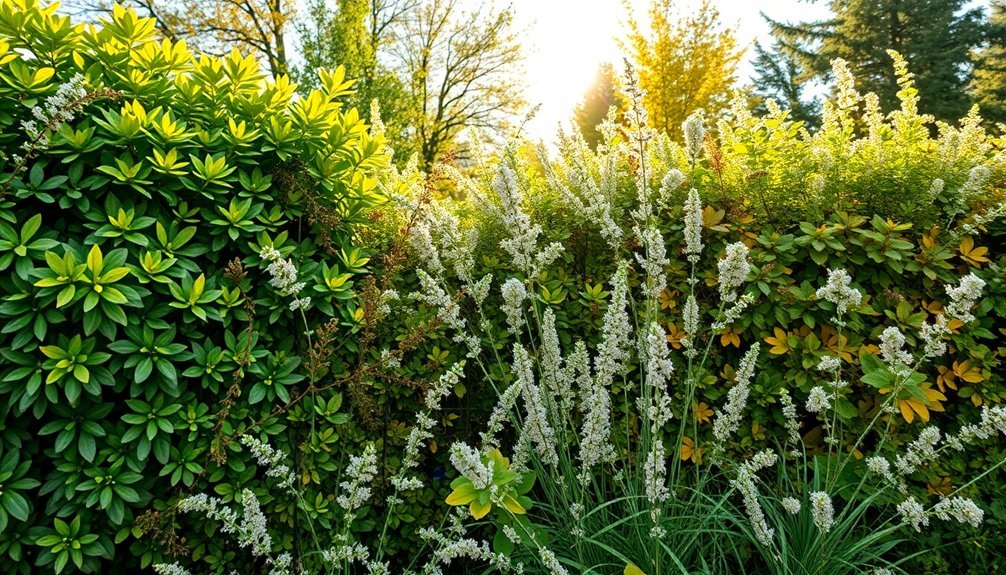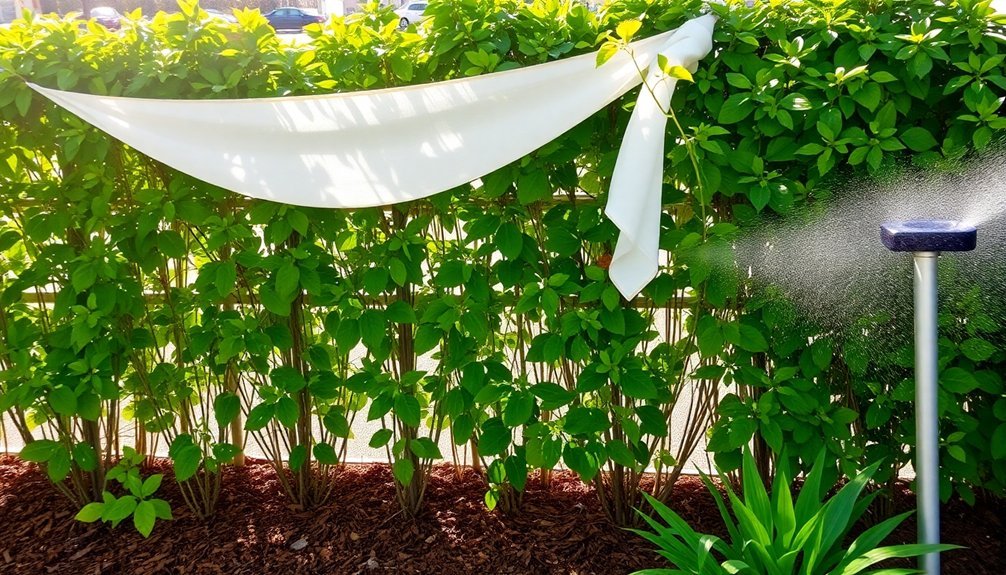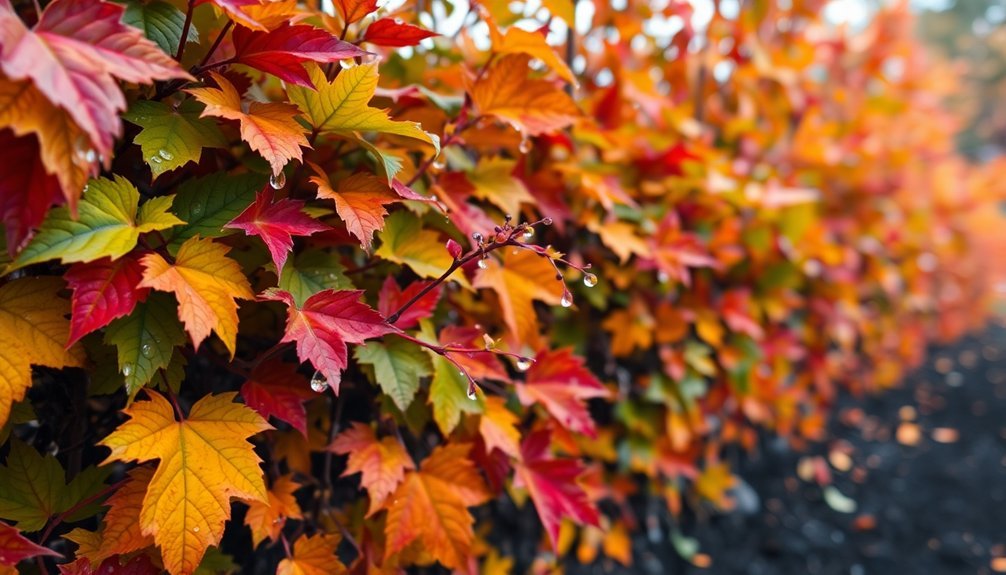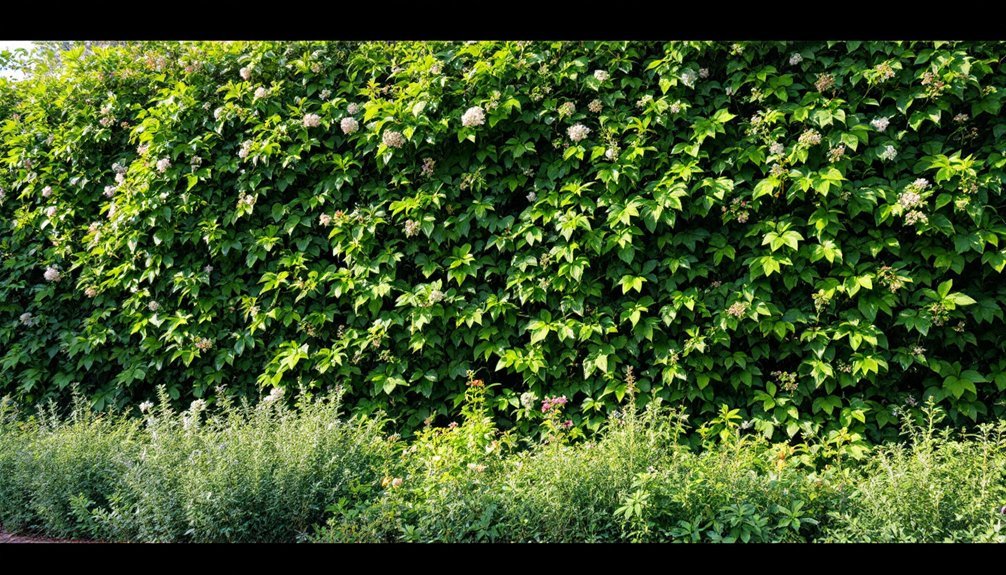Nurturing your living fence requires seasonal attention for year-round health. In spring, prune and fertilize to stimulate growth. During summer, maintain consistent watering with drip irrigation and mulch to combat heat stress. Fall calls for additional mulching and final pruning before dormancy. Winter demands moisture management and protection from harsh elements. Choose native species suited to your hardiness zone for best results. The following strategies will transform your living boundary into a thriving, self-sustaining ecosystem.
Choosing the Right Plant Species for Your Climate Zone

Creating a successful living fence begins with selecting plant species perfectly suited to your local climate. Your first step should be identifying your USDA hardiness zone, which determines which plants can survive your area's minimum temperatures.
The foundation of every thriving living fence lies in choosing plants that harmonize with your regional climate conditions.
In cold regions, prioritize hardy natives like birch or spruce that withstand frost and provide soil stabilization. Climate change is increasingly shifting zone boundaries, requiring gardeners to consider both current and future climate conditions. Consider the length of your growing season and select quick-maturing varieties when needed.
For challenging microclimates, create sheltered areas to protect sensitive species from harsh winds.
Don't overlook soil conditions—choose plants that thrive in your soil type and drainage situation. The most successful living fences balance practical considerations with aesthetic appeal, incorporating diverse foliage, seasonal interest, and pollinator-friendly options while avoiding potentially invasive species.
Spring Awakening: Essential Care for New Growth
As winter retreats and temperatures rise, your living fence enters a period of rapid growth that demands specific attention.
Start by pruning in early spring to stimulate vigorous growth and maintain your desired shape. Apply balanced organic fertilizers with equal parts nitrogen, phosphorus, and potassium before new growth begins. Consider which plants in your fence would benefit from additional seasonal color changes to enhance the visual appeal throughout the year.
- Check soil moisture regularly and adjust watering schedules based on local conditions
- Install drip irrigation or soaker hoses for efficient watering of newly planted sections
- Apply organic mulch around plant bases, avoiding direct contact with stems
- Inspect plants frequently for early signs of pests, especially spring aphids
- Remove dead leaves and debris to prevent fungal diseases and improve appearance
Remember to introduce beneficial insects as natural pest control while monitoring your hedge's development through this critical growth period.
Summer Heat Challenges and Protection Strategies

Summer's intense heat demands strategic protection for your living fence through targeted shade management and careful plant positioning.
You'll find greater success with heat-resistant varieties like juniper, yew, and oleander that withstand scorching temperatures while maintaining visual appeal.
During drought periods, maintain proper hydration by implementing drip irrigation systems and applying mulch to conserve soil moisture. Living fences help create cooling microclimates that can benefit your entire garden space during hot summer months.
Shade and Heat Management
While many gardeners focus primarily on aesthetics, the shade-giving properties of your living fence become invaluable during summer's intense heat.
Dense planting not only provides privacy but creates a microclimate that reduces soil dryout and protects surrounding plants. Your living fence serves as a natural cooling system, reducing your property's temperature and potentially lowering cooling costs. Monitor your plants for signs of stress such as droopy plants during particularly hot and dry periods.
- Mulch around the base of fence plants to retain moisture and prevent evaporation
- Install drip irrigation for efficient watering during heat waves
- Add climbing plants to trellises for increased vertical shade coverage
- Prune regularly to maintain healthy foliage for ideal shade production
- Incorporate drought-tolerant species to reduce watering needs during dry spells
Heat-Resistant Plant Varieties
When temperatures soar, selecting the right heat-resistant varieties becomes essential for maintaining a thriving living fence.
Consider white fir or Kentucky coffeetree for taller barriers, while Osage orange offers exceptional drought resistance and natural security.
For mid-level coverage, glossy abelia provides vibrant flowers despite heat stress, and juniper offers versatile, year-round protection.
Smokebush delivers stunning foliage while enduring hot conditions.
The ornamental grasses add texture and movement to your living fence while thriving in high temperatures with minimal water requirements.
Don't overlook edibles like rosemary and thyme, which serve dual purposes as both culinary herbs and resilient fence components.
Mulberry and strawberry guava can create productive boundaries that flourish in full sun.
Enhance protection by incorporating thorny species like pyracanthas.
Regular pruning, equal NPK fertilization, and organic pest management with hot pepper solutions will keep your living fence robust throughout summer's challenges.
Hydration During Drought
Selecting heat-resistant plants is only half the battle in maintaining a thriving living fence. During drought periods, your fence requires strategic hydration to survive the harsh conditions.
Implementing water conservation techniques guarantees your living barrier remains vigorous even when rainfall is scarce.
- Establish drip irrigation systems to deliver water directly to plant roots, minimizing waste
- Apply organic mulch around your fence line to retain soil moisture and reduce evaporation
- Collect rainwater in barrels to sustain your fence during water restrictions
- Create microclimates with strategic shade placement to protect sensitive sections
- Encourage mycorrhizal fungi growth by adding compost to boost drought resilience
Consider incorporating silver-leaved plants like dusty miller and artemisia for their natural ability to withstand hot, dry conditions.
Monitor soil moisture regularly and adjust your watering schedule accordingly.
Remember that overwatering can be as harmful as underwatering, especially during summer heat.
Fall Preparation: Fortifying Living Fences Before Winter

As temperatures drop, you'll need to apply mulch around your living fence's base to insulate roots against frost damage.
Late fall pruning should focus on removing dead branches while maintaining the fence's structure and strength for winter snow loads. Consider using general or specialty fertilizers for plants before the ground freezes to provide nutrients for early spring growth.
Don't forget to inspect for pests that might overwinter in your fence, applying appropriate treatments now to prevent spring infestations.
Mulch for Frost Protection
The secret to winterizing your living fence effectively lies in proper mulching techniques. Apply a 2-4 inch layer of mulch after the first frost to protect root systems while deterring pests that might overwinter. This protective barrier stabilizes soil temperature, prevents heaving during freeze-thaw cycles, and locks in vital moisture during drying winter winds. Mulch primarily serves as a surface layer insulator that slows cold penetration by several hours, though it won't prevent ground freezing for extended periods.
- Focus mulch application around root zones for maximum protection
- Combine with snow coverage for enhanced insulation effect
- Keep mulch away from stems to prevent rot and disease
- Pair with frost covers for additional protection during severe cold
- Thin out mulch in spring to allow soil to warm and breathe
Remember to remove debris before application and consider adding compost underneath for slow-release nutrients throughout winter.
Late Pruning Techniques
While mulching protects your living fence's root system, proper late-fall pruning safeguards its above-ground structure. Complete major pruning by late fall to prevent winter damage.
Focus on removing diseased or damaged branches to halt disease spread before winter sets in. When pruning, aim to maintain structural integrity by thinning dense growth to allow sunlight penetration to lower branches.
This strategic approach minimizes the risk of breakage from ice and snow accumulation. Use appropriate tools—hand pruners for precision cuts on smaller branches, loppers for medium-sized limbs, and hedge clippers for overall shaping.
Pay special attention to vulnerable limbs that mightn't withstand winter's weight. Remember that proper pruning now saves extensive repair work in spring and supports healthier growth when the season turns. Delay any extensive pruning of species that tend to "bleed" heavily until they are dormant to avoid creating entry points for pathogens when sap is flowing.
Pest Prevention Strategies
Preparing your living fence for winter must include thorough pest prevention strategies to avoid unwelcome surprises come spring. As temperatures drop, pests seek shelter within your living fence structure. You'll need to act now to create effective barriers while preserving your fence's integrity.
- Trim overgrown branches and shrubbery to eliminate bridges pests might use to bypass your fence and reduce shade that provides ideal conditions for carpenter ants to thrive.
- Seal any gaps in traditional elements of your living fence to block small invaders.
- Incorporate native plants known to repel common pests or attract their natural predators.
- Apply organic deterrents like neem oil around vulnerable areas without harming beneficial insects.
- Install physical barriers to prevent larger animals from climbing or burrowing through your living fence.
Regular inspection throughout fall guarantees you'll catch potential issues before winter sets in.
Winter Dormancy Management for Long-Term Health

Despite appearing inactive above ground, your living fence continues its vital development beneath the soil during winter months. Maintaining proper moisture balance is essential—roots need hydration without becoming waterlogged.
Winter dormancy is an illusion—beneath the soil, your living fence continues its essential growth journey through careful moisture management.
Apply a 2-3 inch layer of mulch or hay to insulate roots and retain soil moisture. Water your living fence deeply before the ground freezes, especially if precipitation has been scarce. This provides insulation against freezing temperatures and supports ongoing root function. For effective protection against winter winds, orient your windbreak rows perpendicular to prevailing winds, which typically come from the northwest in Colorado.
Consider using soil moisture sensors to monitor hydration levels accurately. Protect your fence from harsh elements with breathable covers during extreme cold snaps, and regularly clear accumulated snow to prevent breakage.
Choose plant species adapted to your local soil conditions and climate for best resilience. Remember to inspect for rodent damage throughout winter, applying protective measures promptly when needed.
Pruning Techniques to Enhance Density and Security
Your living fence's density and security depend on strategic cutting patterns that channel growth where it's most needed.
By pruning branches at varied heights and angles, you'll create overlapping foliage that blocks sightlines while maintaining a natural appearance.
When shaping for privacy, focus your efforts on eye-level zones, creating a thicker barrier where it matters most for security without sacrificing the fence's overall health. Using hand pruners for smaller branches ensures precision cuts that promote denser growth while preventing damage to the plant's vascular system.
Strategic Cutting Patterns
When properly executed, strategic pruning transforms an ordinary living fence into an impenetrable, lush barrier that enhances both your property's security and aesthetic appeal.
Focus on directional pruning to guide growth where you need additional coverage, while maintaining the natural form of your plants.
- Prune branches at a 45-degree angle above outward-facing buds to encourage lateral growth that creates denser coverage.
- Remove crossing branches to prevent rubbing and disease transmission while improving air circulation.
For hedges with historical significance, consider traditional techniques that have maintained ancient hedgerows for centuries, preserving both their structural integrity and cultural heritage.
- Create a wider base than top (tapering upward) to guarantee lower branches receive adequate sunlight.
- Trim the fence's interior branches to stimulate outward growth and increase density.
- Alternate between deep and light pruning zones to create a layered, textured appearance that's difficult to penetrate.
Privacy-Focused Shaping
Creating an impenetrable living barrier requires specialized pruning techniques that balance density with plant health. When shaping for privacy, focus on developing a wider base than top to allow sunlight penetration while maintaining a solid visual screen. For severely neglected privet hedges, consider cutting back to approximately 6 inches above ground during the dormant winter period.
| Technique | Purpose | Season | Result |
|---|---|---|---|
| Tip pruning | Stimulates lateral growth | Spring | Denser foliage |
| Deep cutting | Encourages interior branching | Winter | Structural strength |
| Graduated trimming | Creates tapered profile | Summer | Light distribution |
| Selective thinning | Improves air circulation | Fall | Disease prevention |
You'll achieve maximum privacy by pruning after new growth appears, cutting 1-2 inches beyond your desired final shape. For established hedges, remove up to one-third of old growth annually to rejuvenate dense coverage without compromising the plant's structural integrity.
Organic Pest Control Methods for Natural Barriers

Living fences face constant threats from pests that can damage their structure and inhibit growth if left unchecked. Implementing organic pest control methods protects your natural barrier while maintaining ecosystem health.
Integrated Pest Management (IPM) offers a thorough approach, combining cultural, biological, and mechanical controls before resorting to plant-based pesticides.
- Create physical barriers with row covers or insect netting to shield plants from unwanted visitors
- Introduce beneficial predators like ladybugs and lacewings to naturally reduce pest populations
- Practice companion planting with pest-repelling species such as marigolds near vulnerable sections
- Apply homemade solutions like neem oil spray or soap mixtures for targeted treatment
- Regularly monitor, prune, and remove debris to eliminate potential pest habitats
Implementing strategic crop rotation around your living fence prevents pest populations from becoming established and targets specific pests before they can cause significant damage.
These methods won't just protect your living fence but will support biodiversity and create a healthier garden ecosystem.
Watering Systems and Moisture Management Year-Round
Effective moisture management stands at the heart of maintaining a thriving living fence throughout all seasons. Drip irrigation delivers water directly to roots, minimizing waste while guaranteeing your plants receive consistent moisture.
Young plants need more frequent watering, especially in their first year. You'll want to install button drippers for efficient delivery in your living fence structure. These can be customized to match the specific needs of different plant species in your barrier.
During dry spells, you'll need to supplement with manual watering, while rainwater often suffices in wetter periods. Consider installing a timer-controlled system that adjusts to seasonal changes.
Remember to regularly inspect for blockages or leaks, particularly before the growing season begins. This preventative maintenance guarantees your living fence receives maximum hydration year-round.
Soil Enrichment for Stronger Root Development
Strong root systems provide the foundation for any successful living fence, making soil enrichment an essential practice for long-term viability.
You'll need to till soil 2 feet wide and deep, incorporating organic matter like compost or manure into the top 2-4 inches. Most fence plants thrive in slightly acidic to neutral soil with pH between 5.5-7.0.
- Apply balanced NPK fertilizers in early spring when roots are actively growing
- Mix leguminous species like black locust between other plants to naturally fix nitrogen
- Mulch around your fence line to retain moisture and prevent weed competition
- Allow leaf litter to decompose naturally, creating rich humus for continued nourishment
- Avoid trampling soil near the fence to prevent compaction that restricts root development
Interplanting Strategies for Multi-Season Visual Appeal
A truly enchanting living fence provides visual interest throughout all four seasons, not just during peak growing periods. By strategically interplanting different species, you'll create a dynamic boundary that transforms with the calendar.
Layer your fence with spring bloomers like dogwoods alongside summer favorites such as hydrangeas. Include maples for stunning autumn colors and incorporate evergreens to maintain structure during winter months.
This height variation—tall trees, medium shrubs, and low ground covers—creates visual depth and complexity.
Don't forget to mix textures and growth habits for added dimension. Consider adding trellises for climbing plants and berry-producing shrubs to attract wildlife.
If you're in a warmer climate, Gliricidia sepium works well, while willow thrives in colder regions. For maximum impact, choose species that naturally complement your existing landscape design.
Repairing Gaps and Weak Points in Living Boundaries
Living fences, like any natural element in your garden, require regular maintenance to address inevitable gaps and weak spots that develop over time.
Begin by conducting regular visual inspections, looking for thinning areas or places where plants have died back. When you've identified weak points, select native, drought-tolerant species for repairs to guarantee longevity and ecosystem benefits.
- Apply organic mulch around new plantings to stabilize soil and retain moisture
- Install temporary supports like stakes or trellises to strengthen vulnerable sections
- Fill gaps with fast-growing companion plants that complement existing species
- Use natural materials like branches or logs as structural reinforcement
- Implement seasonal maintenance schedules to catch potential issues before they worsen
Tools and Equipment for Efficient Living Fence Maintenance
Maintaining your living fence requires the right tools and equipment to secure its health and longevity. Invest in quality pruning shears for regular trimming and pruning saws for thicker branches. A drip irrigation system or soaker hose will guarantee consistent moisture delivery, while soil moisture meters help you monitor watering needs.
Don't overlook structural supports like trellises, stakes, and soft ties to guide growth and provide stability. For soil health, keep trowels, test kits, and organic fertilizers on hand. Mulching materials will suppress weeds and retain moisture.
For seasonal maintenance, equip yourself with leaf rakes, gardening gloves, and hedge shears. Consider using gardening apps to track your maintenance schedule, ensuring you'll never miss essential pruning or fertilizing windows.
Frequently Asked Questions
How Fast Do Living Fences Grow Compared to Installing Traditional Fencing?
While you'll get immediate boundaries with traditional fences, living fences take several years to mature. Some species like shrub willows grow rapidly (15-25 feet in three years), but they'll never match traditional fencing's instant results.
Can I Train My Living Fence to Grow in Specific Patterns?
Yes, you can train living fences into specific patterns using techniques like espaliering, trellising, and wire supports. Select adaptable plants like vines or flexible shrubs, establish a guiding structure, and maintain through regular pruning.
Will My Living Fence Attract Unwanted Wildlife to My Property?
Living fences typically attract beneficial wildlife like birds and pollinators. You'll minimize unwanted visitors by selecting non-fruiting plants, maintaining proper density, and regular pruning. The key is balancing biodiversity with thoughtful plant selection.
How Do Living Fences Affect Property Boundaries and Neighbor Relations?
Living fences establish clear boundaries while enhancing aesthetics. You'll need to maintain them properly and communicate with neighbors beforehand to prevent disputes. They're a shared benefit that can actually improve neighborhood relations when properly planned.
Can I Incorporate Edible Plants Into My Living Fence Design?
Yes, you can incorporate many edible plants into your living fence! Choose fruits like raspberries, herbs like rosemary, or vegetables like cherry tomatoes. They'll provide food while creating privacy and beauty for your property.
In Summary
Your living fence isn't just a boundary—it's a thriving ecosystem that needs your attention year-round. With proper seasonal care, appropriate tools, and thoughtful species selection, you'll enjoy a resilient, beautiful living barrier for decades. Remember, it's the consistent maintenance and adaptability to changing conditions that transforms a simple hedge into a spectacular living fence that enhances your property through every season.





Leave a Reply